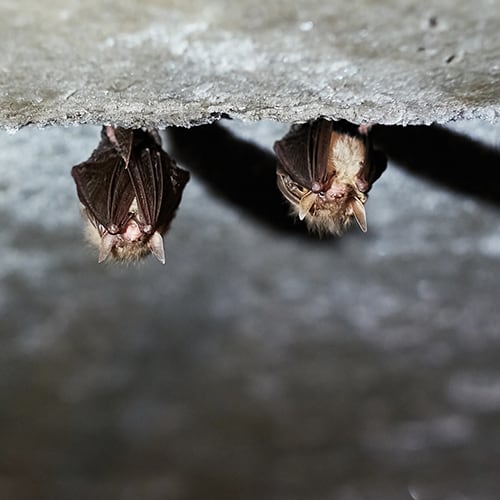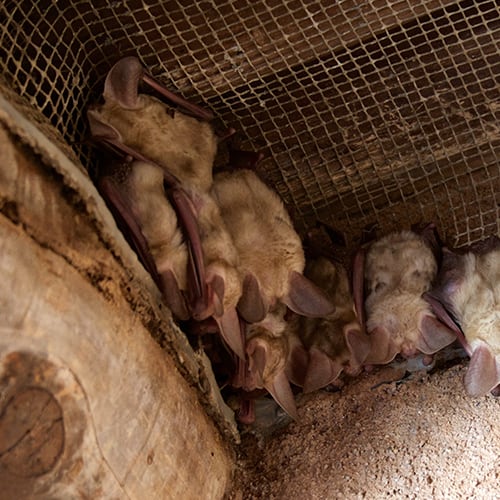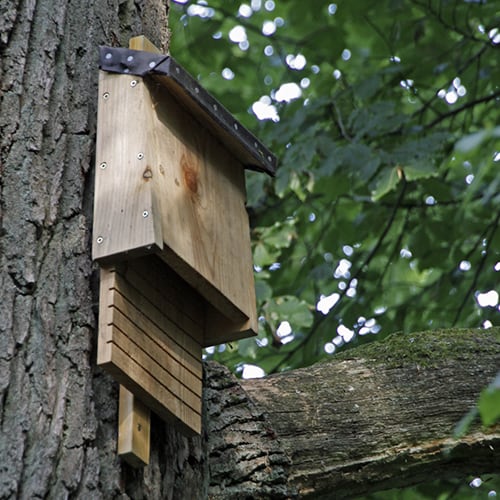Identify

Bats are actually quite benign and even bashful, despite their fearsome appearance. Knowing how to keep your home environment free of bats while allowing them to play their pest management function within the food chain can help you avoid having them considered as nuisances.
Physical Characteristics
- All bats have the same general shape and webbed wing structure.
- The larger bats (“megabats”) may carry a wingspan of up to five feet and a weight of slightly more than two pounds. The smaller type (called “microbats”) may have a wingspan of about six inches and weigh less than one ounce.
- A bat’s flight is more sporadic and swooping than a bird’s movements.
- The face may resemble that of a Chihuahua.
- Some bats live together in colonies typically ranging from 100-1,000 individuals. Others are solitary and live alone.
- Roughly 40-50 bat species call the U.S. home, and more than 1,200 species have been discovered worldwide.
Life Cycle

A female bat’s sluggish reproductive rate (one to two pups per year) is balanced by a bat’s relatively lengthy lifespan (up to 20 years). Females, on the other hand, have a low birth rate, and their populations are vulnerable to decline or extinction due to predators such as hawks, owls, and even snakes.
Males and females meet to breed in hibernation sites during the mating season, which takes place in the autumn. Groups come together to form maternal colonies in the springtime after the pups are born. Mothers go out at night to look for food and drink, then come back to nurse when they return. After a month, the pups leave, generally in the summer. Youngsters are the most likely to wandering into a human dwelling by accident, since they are unfamiliar with flying and the region in general.
Understanding a Bat’s Behavior
- Most North American bats are natural predators to insects. The common bat may eat up to 600 mosquitoes or more per hour – or nearly half its body weight in bugs during a single night. This can help farmers save money on pesticides.
- Why does a bat screech? The technical term is echolocation – a kind of sonar that allows bats to shriek and listen for the echo as a method of nighttime navigation to avoid objects and locate food.
- Bats are the only mammals that can fly. Due to their nocturnal nature, you’ll only see them between dusk and dawn. If a bat flies into your home during daytime, it will be as surprised as you are – and will want to find an exit.
If you encounter one nearby, it is for a specific reason. Your home is likely affected by one or more of the following:
- You live close to a food source. Remember that bats eat insects such as mosquitoes and moths, as well as several kinds of plants and fruits.
- Your home and/or your area offers useful shelter. Darkened and well-shaded locations give bats a place to roost (hang upside-down) during daytime. Indoor roosting sites could include attic space, a barn, roof voids, porch eaves, and even storm drains. Outdoor settings mean caves, hollowed spaces in trees, mine tunnels, and under bridges. Any opening of half an inch or greater is all a bat needs for entry.
- Bats like the temperature and setting.These creatures live all over the world in a variety of geographies: forests, mountains, farmlands, and cities. There are few areas where bats don’t consider at least moderately hospitable. Because much of the U.S. rests in a warm and humid climate, bats will establish roosts in many states.
Seasonal Behavior
Different species of bats handle the seasons in different ways, and temperature extremes impact their lives.

Winter
Some bats store energy from the fat they’ve gained throughout the year and do not eat during hibernation. Each year, bats will congregate in the same area (known as a hibernaculum) to conserve body heat. Barns and attics, as well as caves and tunnels, are all examples of hibernaculum sites. Bats aren’t immune to this behavior, however. Others will migrate south, up to 200 kilometers, during the winter.

Spring
When moms feed their pups and prepare them to leave, nursery colonies are formed. Pups will take to the air after barely one month. A young bat, lacking knowledge of the area, may inadvertently fly into a residence as previously stated.

Summer and Fall
Bats are not visible during the day, as one would expect. From the sun and high temperatures, they hide inside structures or natural settings. When the days start to get colder, mating season begins.
Bat Myths
Let’s dispel a few ideas that give people unnatural fears about bats…
- Myth:Vampire bats suck human blood.
- Fact: Though vampire bats do suck blood, it’s from deer and cattle.
- Myth:Bats are blind, hence the expression “blind as a bat.”
- Fact: Bats have normal eyesight but do use the echoes from their shrieks to guide their nighttime flights.
- Myth:Bats are filthy, disease-carrying animals.
- Fact: As mentioned above, only in rare cases can bats transmit rabies to humans.
Inspect

Signs of Damage

No bat can dig its way inside your house, which is fortunate. They simply aren’t strong enough to break down anything within or create an entrance. Bats instead enter in a variety of places via preexisting holes or crevices.
Bat guano (droppings) should be the biggest concern for home owners. Their trash may breed fungus, which may harm your family if it isn’t cleaned up. The corpse of a bat may rot and emit a strong stench if it gets wedged inside the walls or regions of your home.
Find Their Homes

These flying creatures can only enter your residence when there is a chance, since they are unable to penetrate on their own. Entry points would include:
- Behind shutters
- Broken or torn screens
- Chimney
- Open soffits
- Openings for pipes or wires
- Under eaves, siding, and shingles
- Vents
Seal cracks and seal off holes with caulk or foam insulation if the screens are damaged. When the weather gets colder, this prevents your home from becoming a bat hibernation spot. Bats take flight around dusk, so it’s a good idea to cover these openings then. You’d just be imprisoning them inside your home if you did it during the day.
Prevent

You should routinely implement prevention measures around your property, whether or not you have previously dealt with a bat infestation. Simple measures that will keep your home safe and clean are frequently used.
1. Continuously Monitor Your Home

Even the most well-built houses are vulnerable to weather and wildlife disturbances, and normal wear and tear is unavoidable. Since bats can squeeze into holes as tiny as 3/8″, it’s vital to check your home’s exterior for wear on a regular basis. Bats or other pests will eventually find their way inside if an entryway is accessible. Although your home may not be suitable for a variety of wildlife, it can still provide shelter, heat, and food to sustain them.
2. Maintain Exclusion Practices

Bats are frequently seen in elevated and distant from predators places because they prefer tranquil, unspoiled settings. Try to keep the areas in your house where you spend the most time clean. Bats will be discouraged from entering a noisy or restless environment.
3. Create Alternate Nesting Opportunities

Offering bats a viable alternative outside of your home is really a far better option than dealing with attic bats or any other kind of removal procedure, so doing so may sound like the last thing you would want to do.
You may build a bat house on your own with simple, inexpensive materials or buy one online, in stores. These are usually made of wood and allow for several bats to roost while protecting them from light and allowing for their urine and guano drainage. Where the bats are most likely to fly inside the bat house, you can hang it high up on a tree.
Treat

Bats have been dubbed the vampires of the animal kingdom because to their pointed fangs, cape-like wings, and nocturnal lifestyle. Most bats eat insects, fruits, pollen, and small amphibians like frogs, but one kind of vampire bat does bite animals and drink their blood.
Bats don’t seem to be aggressive, thankfully. Blood-feeding species will not approach humans for any reason. Bats, on the other hand, aren’t picky about where they roost. Attics, chimneys, and overhangs are where they hang out. Homeowners face a range of issues, such as noise, stench, illness, and structural issues caused by their feces and urine.
Treatment Methods
Bats in your house will almost immediately make themselves known to you. Bats hunt in the dark, similar to sonar, and must echolocate their prey since they are nocturnal. Bats must make a high-pitched squeaking sound that is rebounded back to them, informing them where any creatures or physical obstacles are while they fly.
Bats are not particularly antisocial. They fly out of your attic at dusk, so you’ll know they’re leaving their shelter. If bats roost in your attic and are hanging upside down while sleeping, you may catch them during the day. Bats’ feces (also known as guano) and urine are both quite pungent, so you’ll likely smell them before you see or hear them.
1. Locate Bat Entires

First, identify any places where bats are entering and leaving your home before beginning any treatment procedures. This will be a crucial move in your treatment process, allowing you to finish off these later. The following are the entrances you may locate:
- Look for openings in attics and your roof. Bats usually enter buildings in high areas.
- When the bats will fly out to hunt for food, check the exterior of your building just before sunset. isolating the location from where they’re emerging will enable you to see them depart.
- nstead of spending time going over your whole home, once you know the point of entry, you can concentrate your inspection there.
- Shine a flashlight into corners and eaves on your roof and windows, using a ladder for extra stability.
- Any bat entrance will likely be marked with brown stains from grease and oils as well as guano and urine.
2. Repellents

Bats should be encouraged to move elsewhere by making their livong habitat as uncomfortable as possible. There are a variety of ways you might achieve this:
- Store-bought liquid and gel repellents are typically non-toxic and drive bats away with their odor and taste. They include a variety of chemicals, but they’re generally non-toxic. Spray repellents are the easiest way to apply them since you can cover every area where bats may be found. Before using them, wait until they’ve gone to sleep. You must typically reapply these products every 30 days or so, but you should read the instructions thoroughly before doing so.
- Ultrasonic repellents: Ultrasonic repellents irritate bats and other insects and are undetectable to humans, but they emit high-pitched sound waves. These items are available in both brick-and-mortar and online retailers. These are frequently equipped with a motion sensor, which activates when bats fly near, saving battery life.
3. Seal Off and Exclude

It’s time to exclude bats from your home once it has become unsuitable for them. In stores, one-way exclusion devices for bats are available. They’re supposed to stack on top of any entranceway that bats have been utilizing. Bats can exit the attic without returning inside via a one-way valve or tube that is commonly installed. Use them after you’ve applied repellents to your attic, but before you completely seal off the points of entry.
You’ll have to do another inspection similar to the first one you did in order to locate the bat entrances after using the exclusion devices. Pay closer attention to the places inside your home where bats were roosting during the second inspection to determine if any are still there. Outside, check for any more holes or cracks that bats may enter through.
Once you know there are no bats left in your home and have properly identified all of the entrances where they entered, seal off the openings to prevent new infestations. Depending on where the holes are, you might need new shingles, wood, plaster, caulk, or even new windowpanes for this step. You can engage a contractor to conduct a full inspection of your home and use the best materials for the job, which will be especially sure that the problem is handled.
Pro Tip
The best ways to get rid of bats are to repel and exclude them. Bats are illegal to trap or kill, and attempting to do so can be very hazardous since they will become enraged and may hurt you or themselves. Moreover, removing dead bats is considerably more difficult than excluding live animals.
If you have flu-like symptoms after coming into touch with house bats, see a doctor right away. This might be a symptom of rabies or another bat-borne illness.
4. Clean the Affected Areas

The damage caused by a bat infestation’s waste is the most significant effect. Once the bats have left, focus on cleaning up their debris to avoid additional harm.
- Dress properly before you begin, wearing long sleeves, a face mask or respirator, and gloves. This will keep you away from bat guano, which may transmit a variety of ailments if you come into direct contact with it.
- Use a vacuum to collect dried droppings.
- Before vacuuming up the droppings that are adhered to the ground, remove them.
- Use a cleaning solution that is specifically formulated to decompose biological material to clean the whole area.
- Remove the contaminated rugs, carpeting, and furniture that can’t be cleaned.
When To Call a Prefesional

Getting rid of bats may be tough for some people. A bat colony may easily reach inside your insulation, vents, and crawl spaces, gradually destroying your walls and foundation. As a result, hiring an professional may be your finest bet. To successfully locate the bats while also determining their exact species, a wildlife control service will perform a full inspection. As a result, they can create a multi-step, integrated strategy for your home and family.
These experts are outfitted with the finest equipment for keeping them safe while working with bats and their waste, which you may not have or want to buy on your own. Without spending extra money, a wildlife specialist may work with construction companies and cleaning teams to take care of your home’s sealing and cleaning.